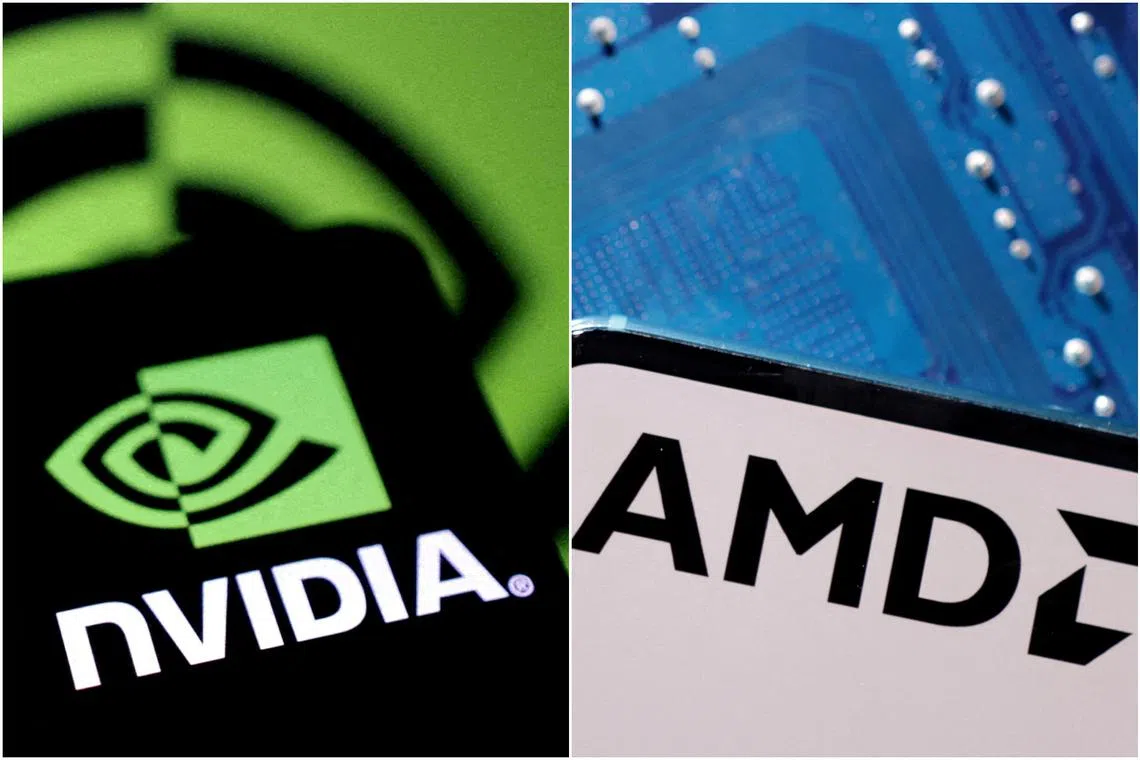Nvidia, AMD to pay 15% of China chip sale revenues to US in unusual move
Sign up now: Get ST's newsletters delivered to your inbox

The arrangement with Nvidia and AMD reflects President Donald Trump’s consistent effort to engineer a financial payout for America in return for concessions on trade.
PHOTOS: REUTERS
Follow topic:
Washington – Nvidia and Advanced Micro Devices (AMD) have agreed to pay the US government 15 per cent of their revenues from sales to China of advanced computer chips in a deal to secure export licences, an unusual arrangement that may unnerve both US companies and Beijing.
Nvidia plans to share 15 per cent of the revenue from sales of its H20 artificial intelligence (AI) accelerator in China, according to a person familiar with the matter.
AMD will deliver the same share from MI308 chip revenues, the person added, asking for anonymity to discuss internal deliberations.
The arrangement reflects US President Donald Trump’s consistent effort to engineer a financial payout for America in return for concessions on trade. His administration has shown a willingness to relax trade conditions like tariffs in return for giant investment in the US – as with Apple’s pledge to spend US$600 billion (S$770.2 billion) on domestic manufacturing. But such a narrow, select export tax has little precedent in modern corporate history.
Beijing, which has grown increasingly hostile to the idea of Chinese firms deploying the H20, is unlikely to warm to the idea of a chip tax. Yuyuantantian, a social media account affiliated with state-run China Central Television that regularly signals Beijing’s thinking about trade, on Aug 10 slammed the chip’s supposed security vulnerabilities and inefficiency.
Mr Jacob Feldgoise, a researcher at the Washington-based Centre for Security and Emerging Technology, said: “This seeming quid pro quo is unprecedented from an export control perspective. The arrangement risks invalidating the national security rationale for US export controls.”
He added: “(It) will likely undermine the US’ position when negotiating with allies to implement complementary controls.
“Allies may not believe US policymakers if they are willing to trade away those same national security concerns for economic concessions – either from US companies or foreign governments.”
An Nvidia spokesperson said the company follows US export rules, adding that while it has not shipped H20 chips to China for months, it hopes the rules will allow US companies to compete in China. AMD did not immediately respond to a request for comment.
The Financial Times earlier reported the development. It followed a separate report from the same outlet that the Commerce Department had begun issuing H20 licences last week, days after Nvidia chief executive officer Jensen Huang met Mr Trump.
Mr Huang has lobbied long and hard for the lifting of restrictions, arguing that walling China off will only slow the spread of American technology and encourage local rivals such as Huawei Technologies.
This is “a strategic bargaining chip” that tightens Washington’s grip on a critical tech sphere during trade negotiations with China, said Ms Hebe Chen, an analyst with Vantage Markets in Melbourne.
“Over time, this hurdle for chips entering China will likely deter Nvidia and AMD from deeper expansion in the world’s largest chip-importing market, while giving local Chinese producers a clear edge to capture market share and accelerate domestic semiconductor innovation.”
If Washington goes ahead with the tax, it should funnel some capital to the US – but not an enormous amount in relative terms. Both Nvidia and AMD have said it will take time to ramp back up production of their China-specific products – even if order levels return to previous levels, which is uncertain.
Nvidia raked in US$4.6 billion of revenue from the H20 in the fiscal quarter ended April 27 – days after new restrictions on shipping the AI accelerator to China were imposed.
It also said it had been unable to take in US$2.5 billion of H20 China revenue in that period because of the new rules. That implies it would have got more than US$7 billion in H20 sales to China during the period. If it can return to that level, the US government will stand to get about a billion dollars a quarter from its deal.
AMD could generate US$3 billion to US$5 billion of 2025 revenue if restrictions were lifted, Morgan Stanley estimated. Chinese alternatives such as Huawei’s Ascend chips now account for 20 per cent to 30 per cent of domestic demand, it reckoned.
“The US government clearly needs the money given its deficits and eagerness to collect tariffs,” said Mr Ling Vey-Sern, managing director at Union Bancaire Privee in Singapore.
“But the complication is China’s accusations about H20 chips containing backdoors, which could be a negotiation tactic to highlight that the country is not ‘hard up’ for US chips.” BLOOMBERG

